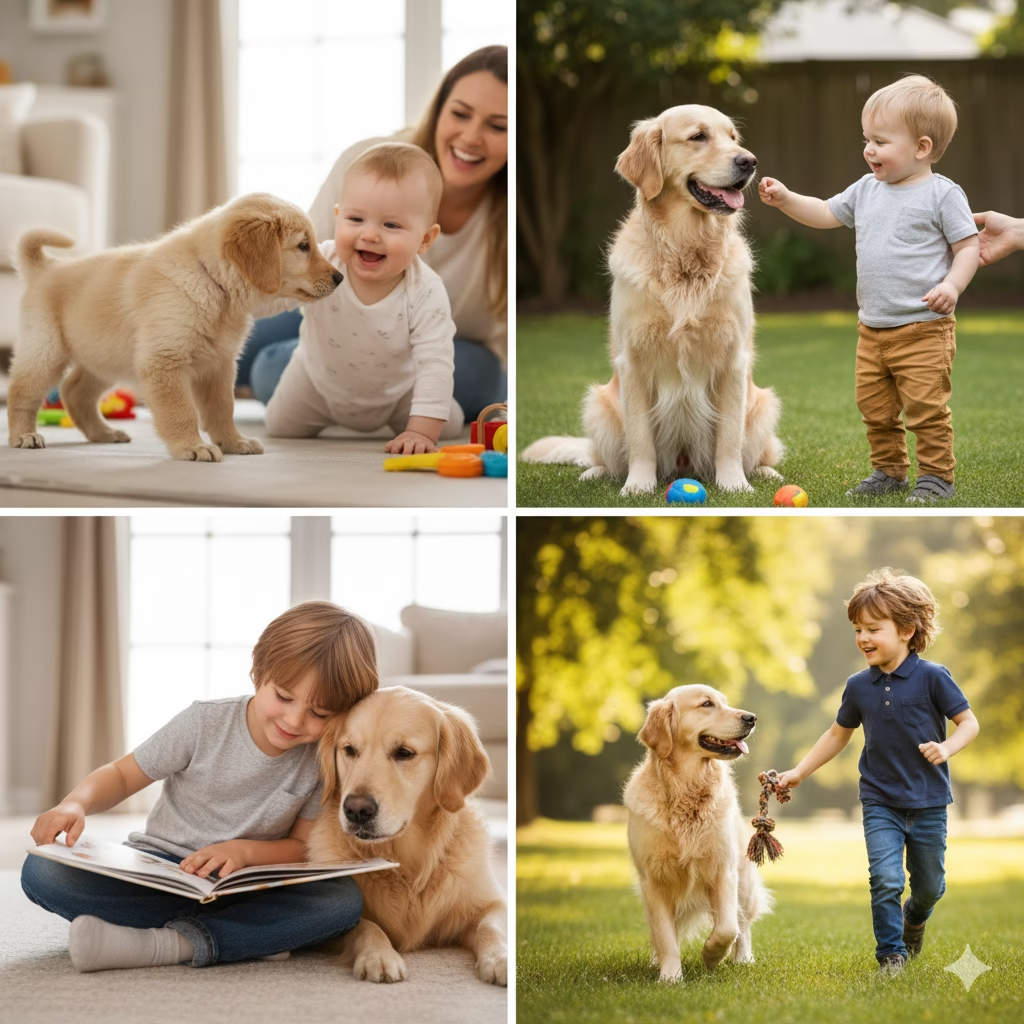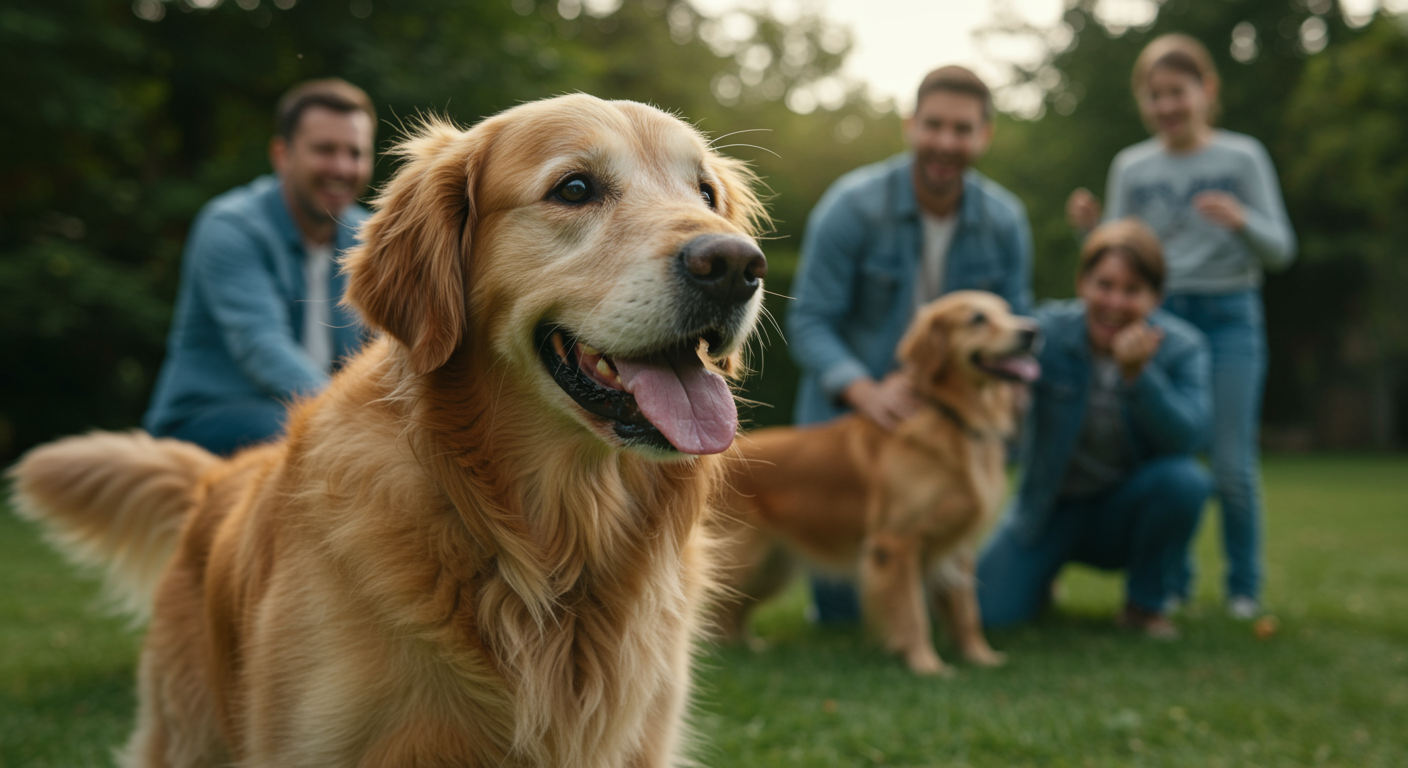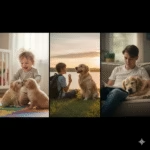The Day Two Heartbeats Joined Our Family
I still remember the silence in the car on the way home. In the back, secured in his crate, was an eight-week-old ball of golden fluff who we’d just named “Cooper.” In the house we were driving towards, my two-year-old daughter was napping, completely unaware that her future best friend was just minutes away. In that quiet moment, a wave of both excitement and profound responsibility washed over me. I wasn’t just bringing home a dog; I was introducing a central character into the story of my daughter’s childhood.
Many people dream of this relationship. We see it in movies and on social media—the loyal dog and the loving child, an inseparable pair. But what I’ve learned over the years is that this incredible bond isn’t something that just happens. It’s not automatic. It’s a living, breathing thing that you must nurture, guide, and protect. It evolves in beautiful, distinct stages, mirroring the growth of both your child and your dog. This is the guide I wish I’d had—a look into the year-by-year journey of how this magical friendship unfolds, and the crucial role you play in writing every chapter.
Stage 1: The Puppy & The Baby/Toddler (Ages 0-3) – The Age of Gentle Discovery
This initial stage is less about a dynamic friendship and more about carefully managed co-existence. It’s a delicate dance of supervision, patience, and setting the groundwork for a lifetime of love. It’s arguably the most demanding phase for you as a parent and owner, but the effort you invest here pays dividends for years.
The World Through Their Eyes
From a puppy’s perspective, your home is a giant, exciting playground, and your toddler is a fascinating, unpredictable new toy. They move in jerky motions, make high-pitched sounds, and are at the perfect height for a curious sniff or a playful nip. Cooper, in his early months, was a “land shark”—all boundless energy and needle-sharp teeth. His intentions were pure play, but his methods were clumsy and needed constant redirection.
From my daughter’s perspective, Cooper was a warm, fluffy, living stuffed animal. She didn’t understand the concept of a dog needing personal space. Her love was expressed through tight hugs, curious ear-pulls, and the occasional attempt to share her soggy cracker with him. Her intentions were pure love, but her methods required just as much guidance as the puppy’s.
My Primary Role: The Gentle Supervisor
During this phase, my mantra was “100% active supervision, 100% of the time.” This doesn’t mean just being in the same room; it means being actively engaged and ready to intervene. My two most important tools were management and redirection.
- Management: We used baby gates to create “puppy-free” and “child-free” zones. Cooper’s crate wasn’t a punishment; it was his safe den, a quiet place he could retreat to when the energy of a toddler became too much. Likewise, my daughter’s playpen was a space where she could play without a curious puppy trying to steal her toys.
- Redirection: This was a constant activity. When Cooper’s teeth got close to my daughter’s hands, I’d immediately say a sharp “Ah-ah!” and redirect his mouth onto a chew toy. When my daughter reached to grab a handful of fur, I would gently take her hand, show her how to stroke softly, and say “Gentle, gentle hands.” We practiced this dozens of times a day.
The bond here is subtle. It’s in the way my daughter would giggle uncontrollably as she watched Cooper chase his tail. It’s in the way Cooper would instinctively settle down at my feet whenever I was nursing or rocking her to sleep. They were learning to be comfortable and calm in each other’s presence, the foundational layer of their entire relationship.
Stage 2: The Young Dog & The Preschooler (Ages 3-6) – The Budding Playmates
This is when the magic really starts to happen. Your child is now more coordinated, communicative, and capable of understanding basic rules. Your Golden, having moved past the intense puppy stage, is more trainable, focused, and has better control over their body. The seeds of a true partnership, planted in the toddler years, begin to sprout.
A World of Imagination and Shared Energy
As my daughter entered her preschool years, her world exploded with imagination. Suddenly, Cooper wasn’t just the family dog; he was a pirate’s first mate, a noble steed on a quest, or a patient at her stuffed-animal veterinary clinic. His eagerness to please and playful nature made him the perfect accomplice in her imaginative games.
This is also the age where we introduced structured play. A gentle game of fetch in the backyard became a daily ritual. I taught her the right way to throw the ball and, just as importantly, how to let Cooper bring it back without grabbing it from his mouth. We played hide-and-seek, where she would hide and I would help Cooper “find” her, his reward being her delighted shrieks of laughter.
My Role as a Coach and Facilitator
My role shifted from constant supervisor to active coach. My goal was to teach them how to interact together safely and respectfully. This involved three key areas:
- Shared Responsibility: I involved my daughter in Cooper’s care routine in simple, age-appropriate ways. She became the “Chief Water Bowl Filler.” Before dinner, it was her job to ask Cooper for a “sit” and then place his food bowl down for him. These small tasks gave her a profound sense of ownership and taught her that caring for him was a privilege and a responsibility.
- Training as a Team: We attended a basic obedience class, and I made sure to practice the lessons at home with my daughter present. She learned the hand signals for “sit” and “down.” Seeing that Cooper would listen to her was incredibly empowering and strengthened their connection.
- Reading Body Language: I started to narrate Cooper’s body language for her. “See how his tail is wagging? He’s so happy you’re home!” or “Cooper is yawning and looking away. That means he’s a little tired and needs some quiet time now.” This helped her develop empathy and understand him as a being with his own feelings and needs.
The bond now is one of active joy. It’s the sound of them chasing each other in the backyard, the sight of her whispering secrets into his furry ear, and the quiet moments when I’d find them curled up together, her reading a picture book aloud to a very attentive, four-legged audience.
Stage 3: The Adult Dog & The School-Aged Child (Ages 7-12) – The Trusted Confidante
By this stage, your Golden Retriever is in their prime—calm, confident, and deeply integrated into the family. Your child is navigating the more complex world of school, friendships, and developing their own identity. The relationship deepens from one of playmates to one of profound, unwavering friendship. Your dog becomes their confidante.
A Deepening Friendship Forged in Trust
The physical energy of their play might lessen slightly, replaced by a deeper emotional connection. Cooper became the one my daughter turned to after a tough day at school. I would often find her lying on the floor with him, her arms wrapped around his neck, just quietly talking. He was a non-judgmental, ever-present source of comfort. He didn’t offer advice or ask questions; he just listened and offered the silent support of his presence.
Their adventures evolved. Family hikes were no longer about me carrying her; it was about her and Cooper racing ahead on the trail, exploring together. He was her shadow, her guardian, and her most enthusiastic cheerleader at backyard soccer games.
My Role as a Trusting Guide
My active management role decreased significantly, replaced by a sense of proud observation and guidance. I could now trust them alone together for periods of time. My focus shifted to reinforcing responsibility and appreciating the mature bond they had formed.
I gave my daughter more significant responsibilities, like helping with his evening brushing and being in charge of his “trick training” sessions, where they would work on new commands together. This wasn’t just a chore; it was their special time. It taught her dedication, patience, and the rewards of hard work. We also began having conversations about Cooper’s health, explaining why vet visits were important and what we needed to do to keep him strong and happy for a long, long time.
Stage 4: The Senior Dog & The Teenager (Ages 13+) – The Quiet Companion
This final stage is perhaps the most poignant and profound. Your child is now a teenager, navigating the turbulent waters of adolescence. Your once boisterous Golden is now a senior citizen. Their muzzle is graying, their steps are slower, but the love in their eyes is deeper than ever.
A Bond of Comfort, History, and Unspoken Understanding
The nature of their relationship changes again. It’s no longer about high-energy games but about shared history and quiet companionship. Cooper, in his senior years, became a grounding force for my teenage daughter. In a world of social pressures, academic stress, and emotional ups and downs, he was her constant. He was a living, breathing link to her own childhood—he was there before she could form long-term memories.
Their time together became quieter. It was about her doing homework on the floor with his head in her lap. It was about watching a movie with him snoring softly beside her on the couch. He didn’t demand anything of her; he simply offered the comfort of his steadfast presence. For a teenager trying to figure out their place in the world, this unconditional, uncomplicated love is an anchor.
My Role as a Grateful Observer
In this stage, my primary role is to ensure Cooper’s comfort and to help my daughter navigate the bittersweet reality of a beloved pet aging. We talk openly about his needs—the shorter walks, the joint supplements, the extra soft bedding. It’s a powerful, real-world lesson in empathy, compassion, and the cycle of life. It prepares her for the inevitable goodbye, not with fear, but with a deep appreciation for the incredible gift his life has been to our family.
Watching them together now, I see more than just a girl and her dog. I see a shared history. I see a quiet understanding that transcends words. I see a friendship that has shaped the person my daughter is becoming—more compassionate, more responsible, and with a greater capacity to love, all thanks to a goofy, golden-hearted dog named Cooper.
A Real-Life Tip: During the ‘Budding Playmates’ stage (ages 3-6), my single best tool was creating “Cooperative Games.” Instead of just fetch, we invented “treasure hunts” where I would “hide” one of Cooper’s favorite toys and my daughter would have to give him the “Go find it!” command. When he found it, they would both celebrate. This taught them to work as a team, making their playtime more engaging and reinforcing their bond in a truly unique way.

Rafael Souza is a digital marketing strategist and lifelong dog enthusiast. Passionate about Golden Retrievers, he shares practical, research-based tips to help owners provide healthier and happier lives for their furry companions.





